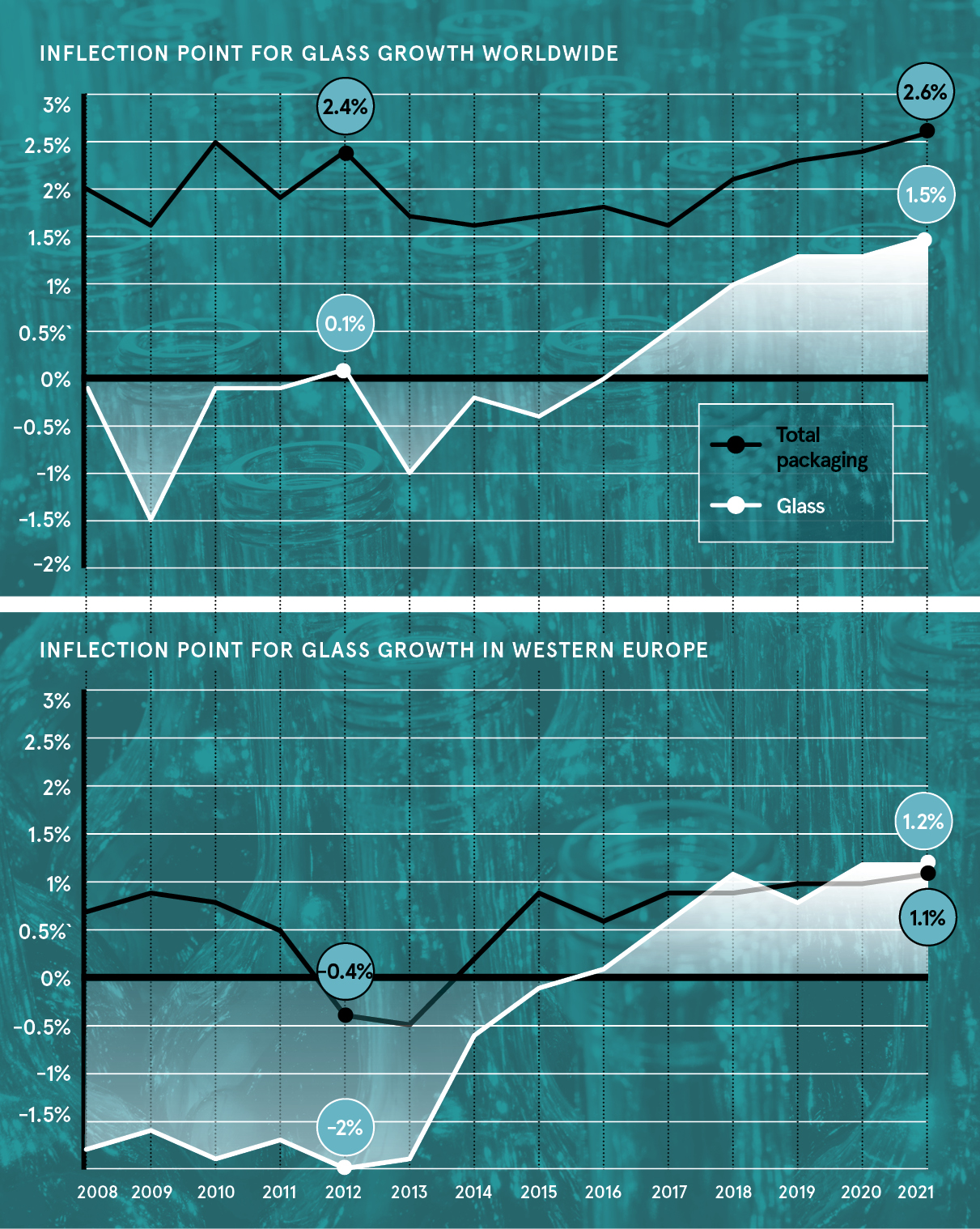Consumers constantly demand more from packaging. They want products to be environmentally friendly, and most are more likely to buy goods in packaging that represents them and their lifestyle. Glass gives brands endlessly recyclable and customisable packaging that empowers them to stand out even in the most fiercely competitive markets. It also allows them to preserve the subtle taste and texture of their products.
While glass, as with all packaging, had for some been viewed as a cost, the material is now increasingly viewed as a powerful brand asset. Euromonitor data shows a steady increase in glass usage since 2016. High glass-share segments, such as premium alcoholic beverages, are continually growing, and there is now increasing use of glass for packaging food and non-alcoholic drinks.
This shift has occurred because glass offers brands a powerful response to consumer demand for greater personalisation and “premiumisation”. “Changing preferences and desires from consumers are forcing food and drinks brands to think creatively how they can generate deep engagement, driving diversification and a redefined role for packaging,” explains Arnaud Aujouannet, chief sales and marketing officer at Owens Illinois (O-I), the world’s largest manufacturer of glass packaging products.
“Glass has a unique ability to bring real emotions to consumers by capturing a brand’s essence. With more than 70 per cent of purchasing decisions made in-store, packaging needs to tell a differentiated brand story at one glance, and glass delivers on that.”
Consumers are influencing brands and governments, and with glass being so recyclable and reusable, it’s the obvious choice for better packaging
High-end spirits makers often look to premiumise the experience with ultra-pure glass and intricate design. “Then there are beer companies that develop a few global brands, which they launch in new markets with a more premium positioning, leveraging glass to support the more sophisticated image,” says Mr Aujouannet.
Meanwhile, food manufacturers seeking to switch a product into glass containers might go for a simple design, with the view that simply the switch from plastic to glass is already creating the premium feel. This was recently exemplified by General Mills’ decision to house its Oui yoghurt product in the United States in glass, which is unusual in the market and gives it a premium edge.
Food and drinks brands find that consumers like the many shapes, colours, embossings and designs on offer, and this is visible in their purchasing. These options make a memorable consumption experience, with many people even collecting and displaying bottles.
Customisation is now well understood to be a driver of consumer behaviour and purchasing decisions, which is why brands are urgently seeking ways of tapping into the trend. A report by Packaging Innovations and ThePackHub recently found that 66 per cent of packaging professionals are implementing personalisation into their offerings. Indeed, Coca-Cola’s recent Share a Coke campaign saw names added to millions of bottle labels, resulting in a 5 per cent annual sales increase.
“We see more companies wanting premium products, which are also customised in line with promotions or key events,” says Mr Aujouannet. “Thanks to recent innovations, such as our customisation service O-I : EXPRESSIONS, glass enables brands to be more responsive to what their customers want and to deliver new products quickly.”
Consumers are also driving a shift towards sustainable packaging and glass clearly has a great deal to offer given it is typically made from an average of 50 per cent recycled glass, and up to 90 per cent for green bottles. Glass bottles can be reused up to 30 times. Some 78 per cent of European consumers told a 2018 Friends of Glass survey that their buying behaviour has changed as a direct result of environmental packaging desires.
“Even though the glass industry has focused on sustainability for many years, the big change is that the work is really driven by consumer desire now,” says Mr Aujouannet. “Consumers are influencing brands and governments, and with glass being so recyclable and reusable, it’s the obvious choice for better packaging.”
Drinks and food companies are acting quickly to make the best use of sustainable glass. As of last year, the Glass is Good programme for collecting used bottles, led by drinks firm Diageo, had collected 43 million one-litre bottles. O-I partners with many such schemes and has invested more than $6 million in glass recycling facilities around the world. The company has also committed to half its glass being post-consumer recycled content by 2025.
For O-I, part of the way forward is to help brands understand more about their consumers and shoppers, and to give them more of what they want, quickly and in ways that can be sustainably successful. This has been the motivation behind the company’s launch of O-I: EXPRESSIONS, which enables brands to combine the benefits of using glass bottles with the promotional potential of easily and almost instantly customisable design.
In addition, O-I’s in-house design services team helps food and beverage companies create innovative and impactful new containers or bottles that make emotional connections between products and consumers.
“There has been a major shift in the last few years around the usage of glass,” says Mr Aujouannet. “Glass is once again viewed as an asset rather than a cost, with all the evidence pointing to strong and growing demand among consumers for premium, personalised and more environmentally friendly packaging.
“Considering the original quality of glass is as a premium product that generates real emotion, we’re glad to see brands extensively using it to catch consumers’ interest on a big scale. They use glass to bring unique, brand-based or tailor-made products to market quickly, with unprecedented flexibility.”
To find out more about using glass packaging as a premium, sustainable brand asset please visit o-i.com


